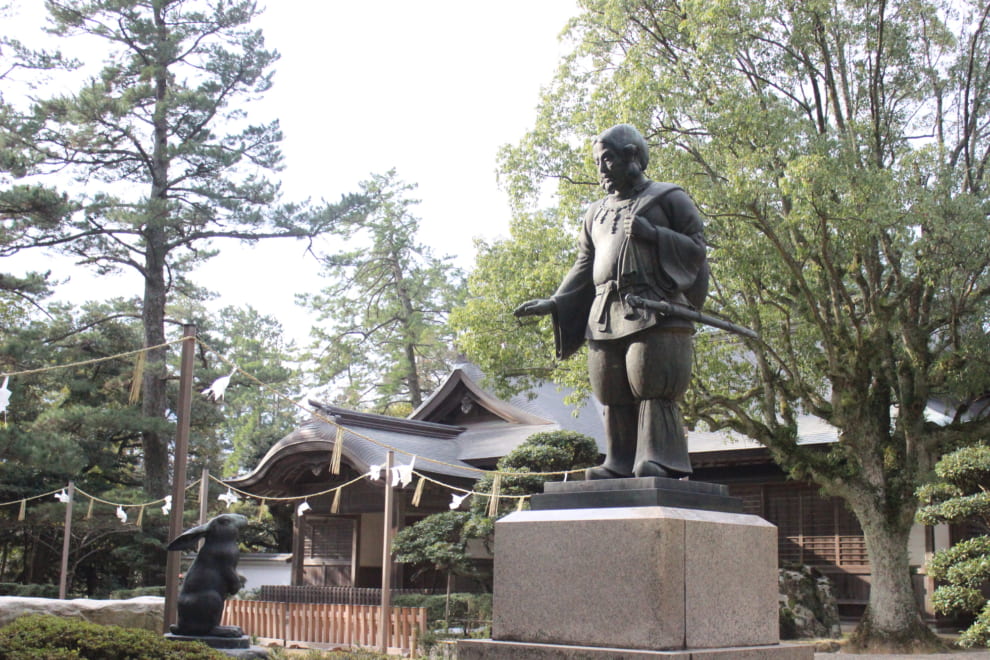The Hare of Inaba: A Pitiful Hare Saved by Okuninushi
Exploring the Kojiki
Updated on Dec 10 2019

Stone statues of Okuninushi and the white rabbit (Izumo Taisha Grand Shrine, Shimane Prefecture)
Hares are animals that have long been very familiar to the Japanese people. At present, people tend to view them as cute pets, yet there are also areas where they are eaten as food. Hares have often been featured in old tales. In the famous Japanese folktale “Kachi-kachi Yama,” a clever hare uses his wisdom to take revenge on the tanuki (Japanese raccoon dog) that killed an old man’s wife.
The hare that makes an appearance in the Kojiki is portrayed in a slightly different light from this wise image. One day, a hare living on an island wishes to cross the sea and visit the opposite shore. Without any means of doing so, however, the hare decides to challenge the “Wani” in the sea to see whose clan is larger – that of the Wani, or that of the hares. The hare made the Wani lie in a row across the sea, and hopped across them from the island to the opposite shore, counting them as he went. Nearing the end, the hare exclaims that he has deceived the Wani in order to use them as a bridge. Angered, the last Wani attacks the hare, ripping his fur from him.
As the hare sat crying, flayed and in pain, the brothers of Okuninushi that were traveling through the region falsely advised the hare to bathe in the sea and dry itself in the wind. Of course, this only resulted in the hare’s wounds worsening. As the hare sat crying once more, Okuninushi, who arrived after his brothers, told the hare to “bathe in fresh water from the mouth of a river, and then roll in the pollen of cattails.” This time, the body of the hare was perfectly restored to its original state with its full and shiny coat of fur.
Now healed of his wounds, the hare transforms into a god, prophesizing to Okuninushi, “While you may now be resigned to carrying your brothers’ luggage, the beautiful goddess Yagami-Hime will be sure to choose you as her partner in marriage.”
This hare is called the Shiro Usagi. We may find ourselves imagining a white hare since “shiro” in Japanese stands for the color white, yet in this context it means “bare” or “naked,” and thus is considered as pointing to brown-colored hares in the wild.
Hearing the word “Wani,” Japanese people today may think of a crocodile. Crocodiles, however, do not exist in Japan’s coastal waters, and therefore one assumes that “Wani” had in fact been used to refer to sharks.
When we come to learn of the animals that the ancient Japanese people had lived with, we are also able to deepen our understanding towards myths.
The hare in this myth is a slightly foolish animal that suffers great pain due to its deceitful scheme. It can be interpreted that the hare’s experience of being revived from its near fatal injury is what resulted in its great growth, and ultimately led to its transformation into a god. An animal overcomes an ordeal and becomes a god. Such tales indeed reflect the very nature of Japanese mythology that has made gods out of various presences that reside within nature.
Kikuko HIRAFUJI
Research
Mythology, Religious Study, History of Religion
Papers
Deities in the interwar period(2023/09/08)
Translation Issues in Kojiki: God, Deity, or Spirit?(2016/01/01)

